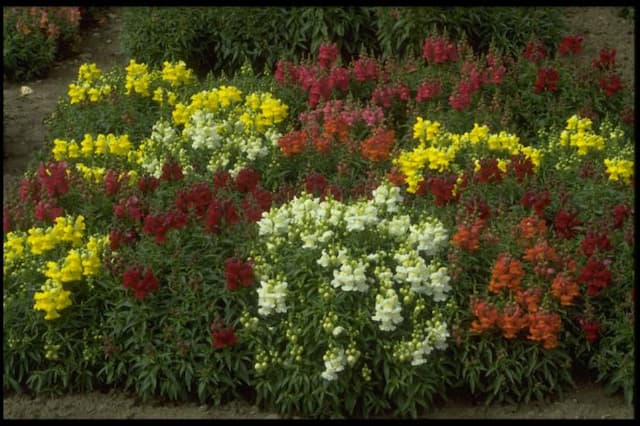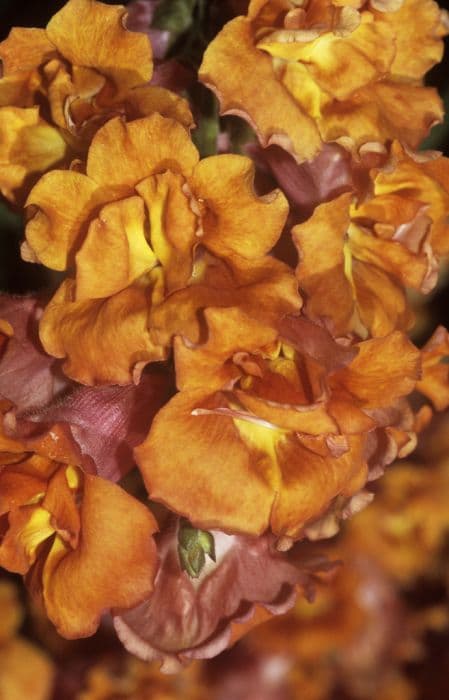Broadleaf Speedwell Veronica austriaca subsp. teucrium

ABOUT
Veronica austriaca subsp. teucrium, commonly known as Austrian Speedwell or Broadleaf Speedwell, is a captivating perennial that catches the eye with its distinctive floral display. The plant brandishes a lush foliage of rich green leaves that exhibit a coarsely toothed margin and an elongated, lance-shaped silhouette. These leaves are often arranged in a manner that creates a dense mat, providing a striking backdrop to the blooms. The flowers of the Austrian Speedwell are truly the stars of the show, presenting themselves in striking spikes that rise elegantly above the foliage. Each individual blossom is a delicate work of nature, small and tubular with a symmetry that is both simple and intricate. They boast a vivid blue to violet hue, sometimes with a hint of pink, and carry a lighter or white center which only adds to their enchanting look. These floral spires bloom profusely, creating a vibrant spectacle that is amplified by their tendency to cluster in groups, forming a sea of color that can captivate any onlooker. Despite being relatively unassuming when not in bloom, the Austrian Speedwell transforms into a focal point of any garden or natural space when its flowers emerge, signaling the arrival of warmer days. In summary, the Austrian Speedwell is defined by its toothed leaves and elegant flower spikes that display a resplendent blue to violet coloration. Its ability to form a dense mat coupled with the striking appearance of its blooms makes it a cherished addition to any setting that seeks to harness the natural beauty of flowering perennials.
About this plant
 Names
NamesFamily
Plantaginaceae
Synonyms
Austrian Speedwell, Broadleaf Speedwell, Saw-leaved Speedwell
Common names
Veronica teucrium, Veronica latifolia, Veronica teucrium var. latifolia, Veronica austriaca.
 Toxicity
ToxicityTo humans
The plant commonly known as Austrian Speedwell is not known to be toxic to humans. While it is generally considered safe, ingestion of any plant material could potentially cause some gastrointestinal discomfort due to the presence of unusual plant compounds that human digestive systems are not accustomed to processing.
To pets
Austrian Speedwell is not specifically listed as toxic to pets. However, as with many plants that are not commonly eaten by pets, it could potentially lead to mild gastrointestinal upset if ingested in large quantities. Signs of this could include vomiting or diarrhea, but such reactions are not commonly reported. It is always best to prevent pets from ingesting plants not intended for their consumption to avoid any possible adverse effects.
 Characteristics
CharacteristicsLife cycle
Perennials
Foliage type
Deciduous
Color of leaves
Green
Flower color
Blue
Height
1-2 feet (30-60 cm)
Spread
1-2 feet (30-60 cm)
Plant type
Herb
Hardiness zones
4
Native area
Europe
Benefits
 General Benefits
General Benefits- Pollinator Attraction: Attracts bees and other pollinators, which is beneficial for garden pollination and local ecosystems.
- Aesthetic Appeal: Offers ornamental value with its bright blue to violet flowers, enhancing the visual appeal of gardens and landscapes.
- Drought Tolerance: Once established, it is relatively drought-tolerant, making it suitable for low-water gardens and reducing the need for irrigation.
- Erosion Control: Can be used to stabilize soil and prevent erosion on slopes due to its spreading habit.
- Low Maintenance: Requires minimal care once established, thus less labor-intensive for gardeners and landscapers.
- Wildlife Habitat: Provides shelter and breeding spots for insects, contributing to biodiversity.
- Ground Cover: Its dense and spreading growth habit makes it an effective ground cover, suppressing weeds and covering bare spots.
- Seasonal Interest: Has a long flowering period, which can provide color and interest in the garden from spring to summer.
 Medical Properties
Medical Properties- Anti-inflammatory: Veronica austriaca subsp. teucrium is sometimes used in traditional medicine for its potential to reduce inflammation.
- Astringent: The astringent properties of the plant may be useful in tightening tissues and reducing secretions.
 Air-purifying Qualities
Air-purifying QualitiesThis plant is not specifically known for air purifying qualities.
 Other Uses
Other Uses- As a natural dye: Veronica austriaca subsp. teucrium can be used to create natural dyes for textiles, with varying shades depending on the mordant used.
- Garden aesthetics: With its vibrant blue to violet flowers, it's often used to add color to rock gardens and border frontages.
- Perennial ground cover: Due to its mat-forming growth habit, this species can serve as an effective ground cover, reducing soil erosion and suppressing weeds.
- Companion planting: Gardeners sometimes plant Veronica austriaca subsp. teucrium near roses and other perennials to enhance garden biodiversity.
- Beneficial insects attraction: The plant is known to attract bees and butterflies, which can aid in the pollination of nearby plants.
- Educational tool: It can be used in schools and educational programs to teach about plant biology and pollination.
- Fauna habitat: Its dense foliage provides shelter for small insects and animals in a garden ecosystem.
- Pressing and framing: The flowers and foliage can be pressed and framed as botanical art.
- Craft projects: Dried stems and flowers can be used in various craft projects, including wreaths and floral arrangements.
- Photography subject: Its striking blooms make Veronica austriaca subsp. teucrium a popular subject for nature and macro photography.
Interesting Facts
 Feng Shui
Feng ShuiThe Austrian Speedwell is not used in Feng Shui practice.
 Zodiac Sign Compitability
Zodiac Sign CompitabilityThe Austrian Speedwell is not used in astrology practice.
 Plant Symbolism
Plant Symbolism- Fidelity: Veronica austriaca subsp. teucrium, also known as the Austrian Speedwell, is often associated with fidelity and steadfastness in floral language due to its enduring and unwavering blooms that persistently return each year.
- Healing: The plant has a history of being used in traditional medicine, which leads to its connection with healing both physical ailments and emotional wounds.
- Clarity: The clear, blue flowers of the Austrian Speedwell are linked to the concept of clarity, offering a sense of clear vision and purpose to those who behold or receive it.
 Water
WaterFor the broadleaf speedwell, it is important to maintain a balance in soil moisture. Water the plant deeply once a week, providing about 1 gallon of water per square foot of soil, which allows the moisture to reach the deep roots. During hot and dry periods, increase the frequency to twice a week. Always check the soil moisture before watering; the top inch should feel dry to the touch. Overwatering or letting the soil stay soggy can lead to root rot, so ensure proper drainage.
 Light
LightBroadleaf speedwell thrives best in full sun to partial shade. Ideally, place the plant in a location where it receives at least 6 hours of sunlight each day. Some dappled shade during the hottest part of the day is beneficial, especially in regions with intense summer sun.
 Temperature
TemperatureThe broadleaf speedwell prefers a temperate climate and can tolerate a wide range of temperatures. It is hardy in USDA zones 4 through 8, which means it can withstand minimum winter temperatures of -30 to 20 degrees Fahrenheit. The ideal growing temperature for this plant is between 60 and 70 degrees Fahrenheit, ensuring healthy growth and blooming.
 Pruning
PruningPrune broadleaf speedwell to maintain shape, encourage bushier growth, and enhance blooming. Deadhead spent flowers regularly to encourage new blooms. In early spring or after the first flowering flush, cut back by one-third to promote a second bloom. Pruning is best done with clean, sharp shears to avoid harming the plant.
 Cleaning
CleaningAs needed
 Soil
SoilThe Broadleaf Speedwell thrives best in well-draining soil enriched with organic matter with a pH ranging from 5.8 to 6.8. A potting mix for this plant could consist of loam, peat, and coarse sand or perlite, ensuring good aeration and drainage. Regular feeding with a balanced fertilizer during the growing season will promote vigorous growth and ample flowering.
 Repotting
RepottingThe Broadleaf Speedwell should be repotted approximately every 2-3 years or when it outgrows its current container. It's best to repot during spring to allow the plant to establish in its new pot before the growing season.
 Humidity & Misting
Humidity & MistingThe Broadleaf Speedwell prefers moderate humidity levels and does not require any special humidity adjustments when grown in most outdoor garden environments. As long as it is planted in the right soil conditions, humidity levels in a typical outdoor setting are sufficient.
 Suitable locations
Suitable locationsIndoor
Ensure bright light, well-draining soil, infrequent watering for Broadleaf Speedwell.
Outdoor
Plant in sun to part-shade, moist well-draining soil for Broadleaf Speedwell.
Hardiness zone
4-8 USDA
 Life cycle
Life cycleVeronica austriaca subsp. teucrium, also known as Austrian Speedwell or Broadleaf Speedwell, starts its life cycle as a seed that germinates in early spring. The seedling develops into a rosette of leaves at the soil surface, where it can undergo vernalization if necessary. Upon reaching maturity, it forms a sturdy stem that allows it to grow erect, which then leads to the development of flower spikes with numerous small, vivid blue to violet flowers that typically bloom from late spring to midsummer. After pollination, which is facilitated by insects such as bees, the flowers produce small capsule-like fruits that release seeds. These seeds may either germinate immediately if conditions are favorable or enter a period of dormancy until the following spring. The plant is perennial, which means it can survive for multiple seasons, going dormant in the winter and re-emerging from its rootstock each spring.
 Propogation
PropogationPropogation time
Spring to early summer
The common name for Veronica austriaca subsp. teucrium is Broadleaf Speedwell. Propagation of Broadleaf Speedwell is commonly done by seed or by division. The most popular method is by division, as seeds can be erratic in germination. Division of the plant should ideally be carried out in spring or early fall. To propagate by division, carefully lift an established clump from the ground and use a sharp knife or a shovel to cut the plant into several pieces, making sure that each piece has a portion of root attached. These divisions can then be directly replanted into well-prepared soil, spaced about 12 to 15 inches (approximately 30 to 38 centimeters) apart to allow for growth. Divisions should be watered thoroughly after planting to help establish them.


![Foxglove [Illumination Ruby Slippers]](/_next/image?url=https%3A%2F%2Fplants-admin.emdemapps.com%2Fimages%2Fplants%2F%2Fimages%2F604b5cbc93f0b.png&w=640&q=75)
![Hebe [Garden Beauty Purple]](/_next/image?url=https%3A%2F%2Fplants-admin.emdemapps.com%2Fimages%2Fplants%2F%2Fimages%2F604b646a3d922.png&w=640&q=75)



![Penstemon [Phoenix Appleblossom]](/_next/image?url=https%3A%2F%2Fplants-admin.emdemapps.com%2Fimages%2Fplants%2F%2Fimages%2F604b553795aab.png&w=640&q=75)
